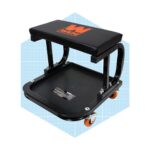Painting your car yourself can be a rewarding DIY project. However, achieving a professional-looking finish requires the right tools and preparation. This guide outlines the essential Tools Needed For Painting A Car, ensuring you’re well-equipped for the task.
Essential Car Painting Tools
Cleaning and Preparation Tools
- Car Washing Supplies: Thoroughly cleaning your car is crucial before painting. You’ll need a pressure washer, car wash soap, sponges, buckets, and microfiber towels for a spotless surface. This removes dirt and grime that can interfere with paint adhesion.
- Sandpaper or Electric Sander: Sanding smooths out imperfections and creates a better surface for paint to adhere to. Use wet/dry sandpaper with a grit count over 1000 for best results on metal surfaces. An electric sander can significantly speed up this process.
- Masking Tape and Film: Protect areas you don’t want painted, like trim, windows, and lights, with high-quality masking tape and masking film. This ensures clean lines and prevents overspray.
Paint Application Tools
- Spray Gun and Air Compressor (Optional): While aerosol spray paint cans are convenient for small jobs, a spray gun and air compressor offer greater control and a more even finish for larger projects like respraying an entire car.
- Micro Applicator: For minor scratches and chips, a micro applicator allows precise paint application without needing to respray a whole panel. This tool is perfect for touch-ups and small repairs.
Finishing Tools
- Buffer: After the paint dries, use an electric orbital buffer to smooth out the new paint and blend it seamlessly with the existing finish. This step creates a professional-looking shine.
Essential Paint Products
- Primer: Primer is a base coat that promotes paint adhesion and ensures a uniform color. Never skip primer – it’s essential for a long-lasting paint job. Choose a high-quality primer specifically designed for automotive use.
- Quality Automotive Paint: Invest in high-quality paint specifically formulated for cars. This ensures durability, color accuracy, and resistance to weather and UV rays. Consider factors like color matching, finish type (gloss, matte), and paint type (acrylic lacquer, acrylic enamel, urethane).
- Cutting Compound: This abrasive compound removes minor scratches and imperfections in the clear coat before applying new paint. It helps achieve a smooth and even surface for a flawless finish.
- Clear Coat: Clear coat protects the paint from UV damage, scratches, and environmental factors. It adds a layer of gloss and enhances the overall appearance of the paint job. Apply clear coat after the color coat has dried.
Safety Gear for Car Painting
- Safety Glasses: Protect your eyes from paint fumes and overspray with safety glasses that meet ANSI Z87.1 standards.
- Respirator Mask: Spray paint contains harmful chemicals. Wear a respirator mask with organic vapor cartridges to protect your lungs and respiratory system.
- Overalls or Workwear: Wear protective clothing to prevent paint from getting on your skin or clothes. Disposable coveralls are a good option.
- Tarp or Drop Cloths: Protect your work area and surrounding surfaces from paint overspray with drop cloths or tarps.
By assembling these necessary tools and materials, and following proper safety precautions, you can achieve professional-looking results when painting your car at home. Remember to consult your local auto parts store for specific product recommendations and expert advice. A successful paint job requires meticulous preparation, patience, and the right equipment.

